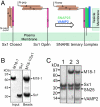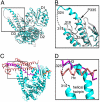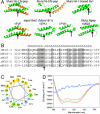Possible roles for Munc18-1 domain 3a and Syntaxin1 N-peptide and C-terminal anchor in SNARE complex formation
- PMID: 21193638
- PMCID: PMC3024693
- DOI: 10.1073/pnas.0914906108
Possible roles for Munc18-1 domain 3a and Syntaxin1 N-peptide and C-terminal anchor in SNARE complex formation
Abstract
Munc18-1 and Syntaxin1 are essential proteins for SNARE-mediated neurotransmission. Munc18-1 participates in synaptic vesicle fusion via dual roles: as a docking/chaperone protein by binding closed Syntaxin1, and as a fusion protein that binds SNARE complexes in a Syntaxin1 N-peptide dependent manner. The two roles are associated with a closed-open Syntaxin1 conformational transition. Here, we show that Syntaxin N-peptide binding to Munc18-1 is not highly selective, suggesting that other parts of the SNARE complex are involved in binding to Munc18-1. We also find that Syntaxin1, with an N peptide and a physically anchored C terminus, binds to Munc18-1 and that this complex can participate in SNARE complex formation. We report a Munc18-1-N-peptide crystal structure that, together with other data, reveals how Munc18-1 might transit from a conformation that binds closed Syntaxin1 to one that may be compatible with binding open Syntaxin1 and SNARE complexes. Our results suggest the possibility that structural transitions occur in both Munc18-1 and Syntaxin1 during their binary interaction. We hypothesize that Munc18-1 domain 3a undergoes a conformational change that may allow coiled-coil interactions with SNARE complexes.
Conflict of interest statement
The authors declare no conflict of interest.
Figures





References
Publication types
MeSH terms
Substances
Associated data
- Actions
- Actions
LinkOut - more resources
Full Text Sources
Other Literature Sources
Molecular Biology Databases

